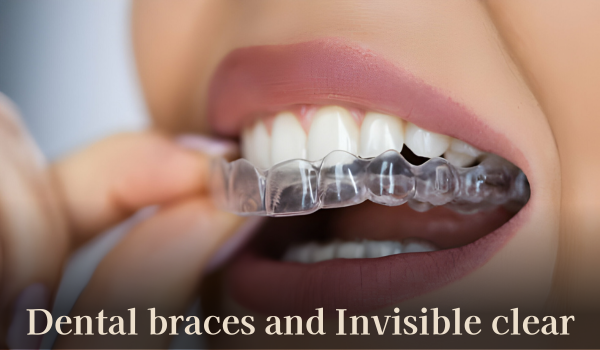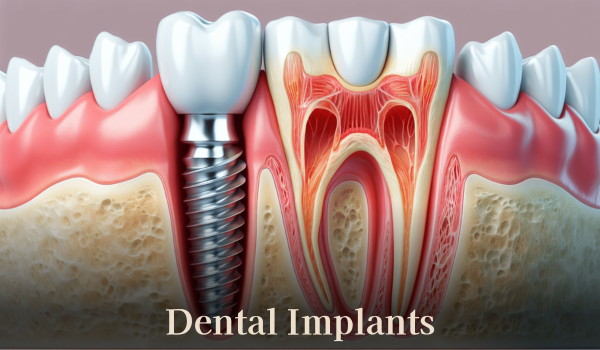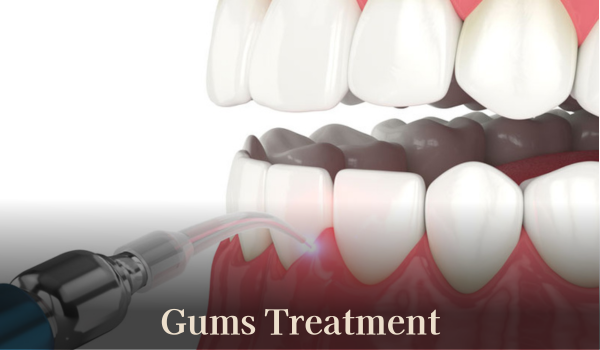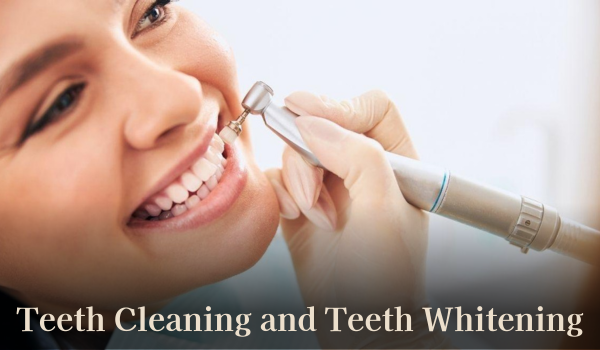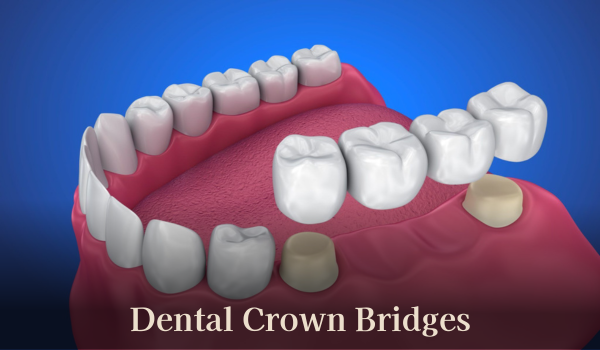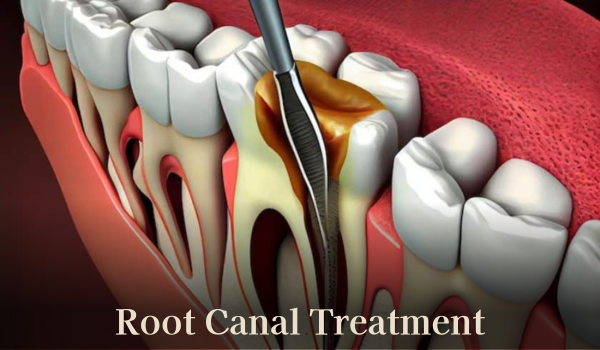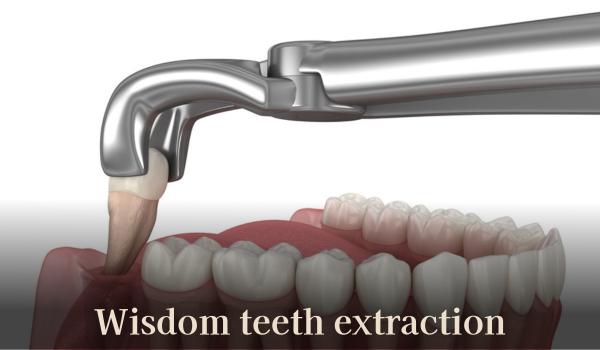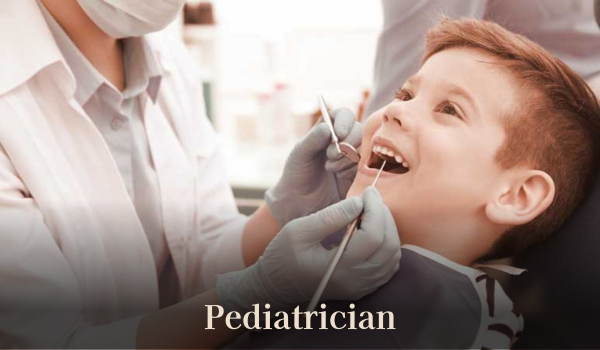Book Appointment Now
Treatments
Dental Braces and Invisible Clear
Dental braces and invisible aligners are both orthodontic treatments used to straighten teeth and correct misaligned bites, but they differ significantly in terms of appearance, comfort, and treatment approach.
Braces are adjusted periodically by an orthodontist to gradually move teeth, while aligners involve a series of custom-made trays that are replaced every few weeks, each one bringing the teeth closer to the desired position.
Dental braces
- Metal Braces: The traditional type is very noticeable due to the metal brackets and wires attached to the front of the teeth.
- Ceramic Braces: A less visible alternative, these are made of tooth-colored or clear ceramic material. Although they blend better with the teeth, the brackets are still somewhat noticeable, particularly the wires.
- Lingual Braces: These are attached to the back of the teeth, making them invisible from the front.
Pre-Care Braces Treatment
- Maintain basic oral hygiene, like brushing and flossing.
- Prepare yourself mentally for the complete procedure
- Stock up on soft foods that are easy to eat, such as soups, yoghurt, and mashed potatoes.
- If you have any cavities, they need to be filled before getting braces to avoid further complications.
- Quit smoking or using any tobacco products because they can stain teeth and increase the risk of gum disease.
Post-Care Braces Treatment
- Attend all follow-up appointments to monitor your progress and adjust the brace as needed.
- Use padding if necessary to prevent the brace from rubbing against the skin and causing irritation.
- Ensure adequate rest and avoid activities that could strain the affected area.
- Maintain a healthy diet to support the healing process.
Invisible Aligner
- Clear aligners are made from transparent, BPA-free plastic.
- Virtually invisible when worn, making them popular for discreet orthodontics.
- Custom-made for a snug fit over the teeth.
- Preferred by adults and teens for subtle teeth straightening
Pre-Care Invisible Aligners
- It’s important to have clean teeth before starting the aligner treatment. Professional cleaning helps remove plaque and tartar, reducing the risk of tooth decay or gum disease while wearing aligners.
- Your orthodontist will provide a detailed plan, outlining the expected duration of treatment, the number of aligners, and the expected results.
- Once the custom aligners are created, you’ll have a fitting appointment where the dentist ensures they fit properly and provide instructions on how to wear them correctly..
Post-Care Invisible Aligners
- Once your aligners come off, your teeth may try to shift back to their original position. Retainers hold your teeth in place to maintain the new alignment..
- Continue brushing your teeth twice a day and flossing daily to maintain your oral health.
- Even after the aligner treatment, it’s essential to visit your dentist regularly for cleanings and checkups to monitor your oral health.
- Avoid particularly sticky or hard foods that could damage a retainer if you’re wearing a removable one. Drink water regularly to prevent dry mouth and help maintain overall oral hygiene.
Dental braces
- Metal Braces: The traditional type is very noticeable due to the metal brackets and wires attached to the front of the teeth.
- Ceramic Braces: A less visible alternative, these are made of tooth-colored or clear ceramic material. Although they blend better with the teeth, the brackets are still somewhat noticeable, particularly the wires.
- Lingual Braces: These are attached to the back of the teeth, making them invisible from the front.
Invisible Aligner
- Clear aligners are made from transparent, BPA-free plastic.
- Virtually invisible when worn, making them popular for discreet orthodontics.
- Custom-made for a snug fit over the teeth.
- Preferred by adults and teens for subtle teeth straightening
Pre-Care Braces Treatment
- Maintain basic oral hygiene, like brushing and flossing.
- Prepare yourself mentally for the complete procedure
- Stock up on soft foods that are easy to eat, such as soups, yoghurt, and mashed potatoes.
- If you have any cavities, they need to be filled before getting braces to avoid further complications.
- Quit smoking or using any tobacco products because they can stain teeth and increase the risk of gum disease.
Pre-Care Invisible Aligners
- It’s important to have clean teeth before starting the aligner treatment. Professional cleaning helps remove plaque and tartar, reducing the risk of tooth decay or gum disease while wearing aligners.
- Your orthodontist will provide a detailed plan, outlining the expected duration of treatment, the number of aligners, and the expected results.
- Once the custom aligners are created, you’ll have a fitting appointment where the dentist ensures they fit properly and provide instructions on how to wear them correctly..
Post-Care Braces Treatment
- Attend all follow-up appointments to monitor your progress and adjust the brace as needed.
- Use padding if necessary to prevent the brace from rubbing against the skin and causing irritation.
- Ensure adequate rest and avoid activities that could strain the affected area.
- Maintain a healthy diet to support the healing process.
Post-Care Invisible Aligners
- Once your aligners come off, your teeth may try to shift back to their original position. Retainers hold your teeth in place to maintain the new alignment..
- Continue brushing your teeth twice a day and flossing daily to maintain your oral health.
- Even after the aligner treatment, it’s essential to visit your dentist regularly for cleanings and checkups to monitor your oral health.
- Avoid particularly sticky or hard foods that could damage a retainer if you’re wearing a removable one. Drink water regularly to prevent dry mouth and help maintain overall oral hygiene.
Dental Implants
Dental implants are a widely used and effective solution for replacing missing teeth. They involve placing a metal post into the jawbone, which acts as an artificial tooth root. Over time, the post fuses with the bone, providing a stable foundation for a replacement tooth, bridge, or denture.
They are a popular and effective solution for replacing missing teeth, offering a durable, natural-looking alternative to traditional dentures or bridges.
Pre-Care Dental Implants
- Wear comfortable, loose-fitting attire on the day of your surgery. After your operation, you will most likely have some minor pain and swelling, and you will not want any tight or constraining apparel to add to your discomfort
- Prior to your dental implant procedure, you may be given a prescription for antibiotics.
- Check with your dentist for exact pre-op instructions; normally, patients must fast between 4 and 12 hours before the operation.
- Don’t hesitate to ask your dentist any questions or express any concerns you may have about the surgery.
Post-Care Dental Implants
- Rest for 24–48 hours and avoid strenuous activities.
- Use gauze to manage bleeding and avoid spitting or rinsing for 24 hours
- Apply ice for swelling and take prescribed pain medications as directed.
- Rinse with salt water after 24 hours, and avoid brushing near the implant for a week.
- Eat soft foods and stay hydrated, but avoid using a straw or eating hard foods.
Gums Treatment
Gum treatment, or periodontal treatment, focuses on addressing gum disease, which can range from mild inflammation to severe infections that can damage the bone supporting your teeth.
- Gingivitis: This is the earliest stage of gum disease. Your gums may become red, swollen, and bleed easily, especially when brushing or flossing.
- Periodontitis: If gingivitis isn’t treated, it can progress to periodontitis. Here, the inner layer of the gum pulls away from the teeth, forming pockets that can become infected.
Pre-Care Gums Treatment
- Inform your dentist about any medical conditions, medications, or allergies. Certain health issues, like diabetes or heart conditions, may require special precautions.
- Prior to your treatment, ensure you’re maintaining good oral hygiene by brushing twice a day with fluoride toothpaste and flossing daily.
- Eating a balanced diet rich in vitamins and minerals, particularly vitamin C, can support gum health and aid in healing.
- Ensure you are well-rested before your appointment. Staying hydrated is also important, as it helps maintain healthy gums and supports overall healing.
Post-Care Gums Treatment
- After the procedure, take it easy for the rest of the day. Avoid strenuous activities, as they can increase blood flow and lead to bleeding.
- Apply a cold compress to the outside of your face in the treated area for 10-15 minutes at a time to reduce swelling and discomfort.
- If the treatment involved deep cleaning or surgery, avoid flossing around the treated area until your dentist advises it’s safe to resume.
- Stick to a soft food diet for the first few days. Opt for foods like yogurt, mashed potatoes, soup, scrambled eggs, and smoothies. Avoid hard, crunchy, or spicy foods that can irritate the gums. Drink plenty of water to stay hydrated, but avoid using straws as the suction can disrupt healing.
- Attend all follow-up appointments so your dentist can monitor the healing process and address any issues that may arise.
Teeth Cleaning and Teeth Whitening
Teeth cleaning and teeth whitening are two different dental procedures aimed at improving oral health and enhancing the appearance of your smile.
The primary goal of teeth cleaning, also known as prophylaxis, is to remove plaque, tartar, and stains from the teeth and gum line. This helps prevent cavities, gum disease, and other oral health issues.
Teeth whitening is a cosmetic procedure aimed at making your teeth whiter by removing stains and discoloration. It’s focused on enhancing the aesthetic appearance of your smile.
Teeth Cleaning
- Routine Cleaning: This is typically performed during your regular dental check-up every six months. It involves removing plaque and tartar from the surfaces of your teeth and polishing them to remove surface stains.
- Deep Cleaning (Scaling and Root Planing): If you have gum disease, your dentist may recommend a deep cleaning. This involves cleaning above and below the gum line to remove bacteria and tartar that have accumulated in the periodontal pockets.
- Prevents cavities and gum disease by removing harmful bacteria and plaque
- Brightens teeth by removing surface stains, though it doesn’t change the natural color of the teeth.
Teeth Whitening
Teeth whitening refers to a variety of processes that aim to make someone’s natural teeth appear brighter and whiter. Teeth whitening methods include sanding down stains, bleaching, ultraviolet (UV) light therapy, and more.
- Teeth whitening options range from toothpaste with whitening ingredients to professional teeth whitening sessions overseen by your dentist.
- Home whitening kits may take the form of a gel or paste that is applied to your teeth using a brush or in the form of sticky strips.
- Tooth whitening at the dentist’s office uses higher concentrations of active ingredients to achieve visible results more quickly.
Pre-Care Teeth Cleaning
- Make sure your dentist is aware of any changes in your health, including new medications, surgeries, or diagnoses..
- Inform your dentist about any allergies you may have, particularly to medications, latex, or other materials that might be used during the cleaning.
- Teeth cleaning typically involves scaling, polishing, and flossing. Ask your dentist or hygienist to explain the process if you’re unfamiliar with it or if it’s been a while since your last cleaning.
- If you’ve noticed any new dental issues, such as bleeding gums, tooth pain, or bad breath, mention these to your dentist before the cleaning starts.
- On the day of your appointment, try to avoid foods and drinks that can stain your teeth, such as coffee, tea, or red wine. This makes it easier for the hygienist to assess your teeth’s natural color and condition.
Pre-Care Teeth Whitening
- A dental cleaning prior to whitening is highly recommended. This removes surface plaque and tartar that could prevent the whitening agent from working effectively on your teeth.
- Teeth whitening can be done in-office, at home with a professional kit, or with over-the-counter products. Discuss with your dentist which method is best for your teeth based on the level of whitening desired, your budget, and your oral health.
- In the days leading up to your whitening treatment, try to avoid consuming foods and beverages that can stain your teeth, such as coffee, tea, red wine, berries, and dark sauces.
- Consider using a whitening toothpaste for a few weeks before your treatment. This can help remove surface stains and start the whitening process gradually.
- Teeth whitening is not permanent, so you may need touch-up treatments every few months or years, depending on your habits and the type of whitening used.
Post-Care Teeth Cleaning
- Use a soft-bristled toothbrush and fluoride toothpaste to brush your teeth at least twice a day. Brushing helps remove any plaque or food particles left after the cleaning. Be gentle to avoid causing any gum irritation or bleeding.
- Pay attention to any changes in your mouth, such as persistent gum bleeding, unusual discomfort, or changes in the alignment of your teeth.
- Drink plenty of water to help rinse away any remaining particles and keep your mouth hydrated.
- For the first 24 hours after a cleaning, avoid foods and beverages that can stain your teeth, such as coffee, tea, red wine, and dark-colored sauces.
- Avoid chewing on ice, pens, or other hard objects that could damage your teeth, especially if they feel sensitive after the cleaning.
- If recommended by your dentist, use a fluoride rinse or gel to help strengthen your enamel and protect against cavities
Post-Care Teeth Whitening
- Continue brushing your teeth twice a day with a non-abrasive whitening toothpaste to help maintain your new smile.
- If you experience sensitivity after whitening, use a toothpaste specifically designed for sensitive teeth.
- Drinking water frequently helps wash away any food particles and keeps your mouth hydrated. Limit the intake of acidic and dehydrating beverages such as alcohol and citrus juices, as they can increase sensitivity and the risk of staining.
- Regular dental visits are crucial to maintaining your oral health and the results of your whitening treatment.
- Don’t hesitate to ask your dentist any questions or express any concerns you may have about the surgery.Your teeth are more porous and susceptible to staining immediately after whitening. For at least 48 hours, avoid consuming foods and drinks that can stain your teeth, such as: Coffee & Tea, Tomato Based Sauces, Sodas, Candies
Teeth Cleaning
- Routine Cleaning: This is typically performed during your regular dental check-up every six months. It involves removing plaque and tartar from the surfaces of your teeth and polishing them to remove surface stains.
- Deep Cleaning (Scaling and Root Planing): If you have gum disease, your dentist may recommend a deep cleaning. This involves cleaning above and below the gum line to remove bacteria and tartar that have accumulated in the periodontal pockets.
- Prevents cavities and gum disease by removing harmful bacteria and plaque
- Brightens teeth by removing surface stains, though it doesn’t change the natural color of the teeth.
Pre-Care Teeth Cleaning
- Make sure your dentist is aware of any changes in your health, including new medications, surgeries, or diagnoses..
- Inform your dentist about any allergies you may have, particularly to medications, latex, or other materials that might be used during the cleaning.
- Teeth cleaning typically involves scaling, polishing, and flossing. Ask your dentist or hygienist to explain the process if you’re unfamiliar with it or if it’s been a while since your last cleaning.
- If you’ve noticed any new dental issues, such as bleeding gums, tooth pain, or bad breath, mention these to your dentist before the cleaning starts.
- On the day of your appointment, try to avoid foods and drinks that can stain your teeth, such as coffee, tea, or red wine. This makes it easier for the hygienist to assess your teeth’s natural color and condition.
Post-Care Teeth Cleaning
- Use a soft-bristled toothbrush and fluoride toothpaste to brush your teeth at least twice a day. Brushing helps remove any plaque or food particles left after the cleaning. Be gentle to avoid causing any gum irritation or bleeding.
- Pay attention to any changes in your mouth, such as persistent gum bleeding, unusual discomfort, or changes in the alignment of your teeth.
- Drink plenty of water to help rinse away any remaining particles and keep your mouth hydrated.
- For the first 24 hours after a cleaning, avoid foods and beverages that can stain your teeth, such as coffee, tea, red wine, and dark-colored sauces.
- Avoid chewing on ice, pens, or other hard objects that could damage your teeth, especially if they feel sensitive after the cleaning.
- If recommended by your dentist, use a fluoride rinse or gel to help strengthen your enamel and protect against cavities
Teeth Whitening
Teeth whitening refers to a variety of processes that aim to make someone’s natural teeth appear brighter and whiter. Teeth whitening methods include sanding down stains, bleaching, ultraviolet (UV) light therapy, and more.
- Teeth whitening options range from toothpaste with whitening ingredients to professional teeth whitening sessions overseen by your dentist.
- Home whitening kits may take the form of a gel or paste that is applied to your teeth using a brush or in the form of sticky strips.
- Tooth whitening at the dentist’s office uses higher concentrations of active ingredients to achieve visible results more quickly.
Pre-Care Teeth Whitening
- A dental cleaning prior to whitening is highly recommended. This removes surface plaque and tartar that could prevent the whitening agent from working effectively on your teeth.
- Teeth whitening can be done in-office, at home with a professional kit, or with over-the-counter products. Discuss with your dentist which method is best for your teeth based on the level of whitening desired, your budget, and your oral health.
- In the days leading up to your whitening treatment, try to avoid consuming foods and beverages that can stain your teeth, such as coffee, tea, red wine, berries, and dark sauces.
- Consider using a whitening toothpaste for a few weeks before your treatment. This can help remove surface stains and start the whitening process gradually.
- Teeth whitening is not permanent, so you may need touch-up treatments every few months or years, depending on your habits and the type of whitening used.
Post-Care Teeth Whitening
- Continue brushing your teeth twice a day with a non-abrasive whitening toothpaste to help maintain your new smile.
- If you experience sensitivity after whitening, use a toothpaste specifically designed for sensitive teeth.
- Drinking water frequently helps wash away any food particles and keeps your mouth hydrated. Limit the intake of acidic and dehydrating beverages such as alcohol and citrus juices, as they can increase sensitivity and the risk of staining.
- Regular dental visits are crucial to maintaining your oral health and the results of your whitening treatment.
- Don’t hesitate to ask your dentist any questions or express any concerns you may have about the surgery.Your teeth are more porous and susceptible to staining immediately after whitening. For at least 48 hours, avoid consuming foods and drinks that can stain your teeth, such as: Coffee & Tea, Tomato Based Sauces, Sodas, Candies
Dental Crown Bridges
A dental crown is a tooth-shaped cap placed over a tooth to restore its shape, size, strength, and appearance. It encases the entire visible portion of a tooth, providing protection and support. Crowns are used to cover teeth that are significantly damaged by decay or trauma. They reinforce teeth that have undergone root canal treatment or are weakened due to large fillings.
- Porcelain: Offers a natural look and is often used for front teeth.
- Metal: Includes gold, platinum, or base metal alloys. These are durable and less likely to wear down over time, often used for back teeth.
- Porcelain-Fused-to-Metal (PFM): Combines the strength of metal with the aesthetics of porcelain. Suitable for both front and back teeth.
- Ceramic or Zirconia: Known for their strength and natural appearance, suitable for various locations in the mouth.
Pre-Care Dental Crown
- Schedule a consultation with your dentist to discuss the need for a crown. Your dentist will examine your tooth and take X-rays to evaluate its condition and the surrounding bone structure.
- If the tooth needing the crown has decay or an infection, these issues must be addressed before the crown is placed.
- The procedure will be performed under local anesthesia, so discuss any concerns you have about anesthesia with your dentist beforehand.
- Plan to eat soft foods after the procedure, especially while wearing a temporary crown. Avoid foods that are very hot or cold, which can cause discomfort.
- Update your dentist on any changes in your medical history or new medications
Post-Care Dental Crown
- It’s normal to experience some discomfort or sensitivity after the procedure. Over-the-counter pain relievers like ibuprofen or acetaminophen can help manage pain.
- Continue to brush your teeth twice a day with fluoride toothpaste. Use a soft-bristled toothbrush to avoid damaging the crown or irritating your gums. Brush gently around the crown to remove plaque and food particles.
- Floss daily, paying extra attention around the crown. Use floss threaders or dental floss designed for crowns to clean effectively without damaging the crown or surrounding teeth. Be gentle when flossing around the temporary crown to prevent it from dislodging
- Try to chew on the opposite side of your mouth from where the crown was placed, especially during the first few days, to avoid putting excessive pressure on the crown.
- Pay attention to any changes, such as the crown feeling loose, discomfort, or any signs of gum irritation.
Root Canal Treatment
Root canal treatment is a dental procedure used to save a tooth that is badly decayed or infected. It involves removing the damaged or infected tissue from inside the tooth, cleaning and disinfecting the root canals, and then sealing and restoring the tooth.
- Pulp Infection: The pulp is infected or inflamed due to bacteria from cavities or trauma.
- Deep Decay: Extensive tooth decay has reached the pulp (the innermost part of the tooth).
- Severe Pain: Persistent toothache, sensitivity to hot or cold, or pain when chewing.
- Abscess Formation: An abscess or swelling at the root of the tooth due to infection.
- Trauma: Injury to the tooth causing damage to the pulp.
Pre-Care Root Canal Treatment
- Ask about the root canal procedure, the materials used, the expected duration, and what to expect during and after the treatment. Discuss any alternative treatments or options if a root canal is not suitable for you.
- Provide your dentist with an updated medical history, including any medical conditions, allergies, and current medications.
- Try to avoid hard, sticky, or chewy foods that could exacerbate the pain or damage the affected tooth before your appointment.
- Talk to your dentist about the type of anesthesia that will be used. Local anesthesia is typically used, but if you have concerns about pain or anxiety, discuss sedation options with your dentist.
- Follow any specific pre-care instructions provided by your dentist.
Post-Care Root Canal Treatment
- It’s common to experience mild sensitivity to hot, cold, or sweet foods and beverages after a cleaning, especially if you had a deep cleaning or scaling and root planing. This should subside within a few days.
- If your gums feel tender or sore, you can take over-the-counter pain relievers like ibuprofen or acetaminophen as needed, following the recommended dosage.
- Brush twice a day, but be gentle around any areas that feel sensitive or tender. Continue to floss daily, but be careful around your gums if they are sensitive
- For the first 24-48 hours, avoid very hot, cold, or acidic foods and beverages, which can trigger sensitivity or discomfort.
- If your gums feel tender, gently massage them with your finger or a soft-bristled toothbrush to promote blood flow and healing.
Wisdom Teeth Extraction
Wisdom Teeth Extraction is a common oral surgery procedure where one or more of the third molars (commonly called wisdom teeth) are removed. These teeth are the last to erupt, usually between the ages of 17 and 25.
Impaction: Wisdom teeth may become impacted, meaning they are unable to fully emerge or grow in at the correct angle due to lack of space in the mouth. This can lead to: Pain, Infection, Damage to neighboring teeth
Crowding: If the mouth doesn’t have enough room, wisdom teeth can push other teeth out of alignment, causing crowding or shifting.
Different Types of Wisdom Teeth


Pre-Care Wisdom teeth extraction
- Your dentist or oral surgeon will take X-rays to assess the position of your wisdom teeth and decide on the best method for extraction.
- Talk with your oral surgeon about the type of anesthesia you’ll be receiving (local, sedation, or general). Make sure you understand any special instructions related to the anesthesia.
- Stop taking blood thinners like aspirin, ibuprofen, or other non-steroidal anti-inflammatory drugs (NSAIDs) for a few days before surgery unless advised otherwise by your dentist or surgeon. These can increase the risk of bleeding.
- Have ice packs ready to manage swelling after surgery. Buy soft foods in advance for after surgery, such as yogurt, applesauce, mashed potatoes, smoothies, and soups. Avoid crunchy or spicy foods for the first few days.
- While wisdom teeth extraction is a routine procedure, some anxiety is normal. Speak with your dentist about any concerns or fears you have
Post-Care Wisdom teeth extraction
- After the extraction, your dentist will place gauze over the extraction sites. Bite down gently but firmly to help form a blood clot. Leave the gauze in place for 30-45 minutes. If bleeding continues, replace the gauze with a new pad, biting down again for 30-45 minutes.
- Avoid Excessive Spitting or Rinsing: This can dislodge the blood clot and lead to a condition called dry socket, which can be very painful.
- Use ice packs on your face for the first 24 hours to reduce swelling. Apply for 20 minutes on and 20 minutes off.
- When sleeping, keep your head elevated with pillows to minimize swelling. After the first 24 hours, switch to warm compresses to reduce swelling and stiffness.
- Rest for at least the first 24-48 hours after surgery. Avoid strenuous activities like heavy lifting or exercise for a few days as this can increase bleeding and swelling.
- For the first 24 hours, stick to a liquid diet. Do not use a straw or your first 48 hours of recovery after wisdom teeth extraction. Doing so will create a suction vacuum inside your mouth and risk dislodging the forming blood clot.Use a spoon to eat smoothies/milkshakes and avoid smoking for the duration of your recovery.
Pediatrician
Pediatric dentist play vital roles in ensuring the overall and oral health of children, often working together to provide comprehensive care.
- Focus: Oral health care for children, including infants, toddlers, and adolescents.
- Education/Training: Dental degree (DDS or DMD), followed by specialized training in pediatric dentistry (usually 2-3 years).
- Preventive dental care, such as fluoride treatments and dental cleanings.
- Diagnosis and treatment of dental issues (e.g., cavities, gum disease, bite alignment).
- Managing dental development and orthodontic needs.
- Addressing dental trauma and emergencies.
- Specialized care for children with special needs.
- Counseling parents on oral hygiene, diet, and habits like thumb-sucking.


